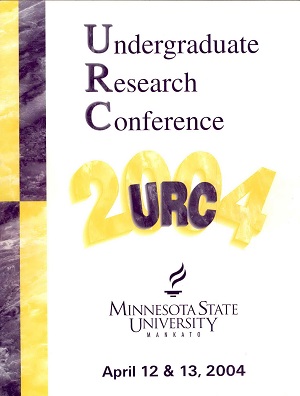The Innate Immune Response in Eisenia fetida (earthworms) to Microbial Challenges
Location
CSU 253
Start Date
13-4-2004 10:30 AM
End Date
13-4-2004 12:00 PM
Student's Major
Biological Sciences
Student's College
Science, Engineering and Technology
Mentor's Name
Dorothy Wrigley
Mentor's Department
Biological Sciences
Mentor's College
Science, Engineering and Technology
Description
The common earthworm, Eiseniafetida, exhibits a rudimentary immune system. The earthworm needs cellular and chemical responses against a constant microbial exposure from its natural environment. Some cellular and chemical responses are found in the coelomic fluid and have been shown to demonstrate anti-microbial characteristics. This project uses microscopy and modified staining techniques to differentiate and categorize the cellular components found in the coelomic fluid. Following a microbial challenge by Klebsiella pneumoniae, an inflammatory response was initiated. Six groups of earthworms were injected with 0.05 ml of 1.0 x 106 cfu/ml K. pneumoniae on day one and tested over a period of five days. A group of three worms was shocked each day for the next five days to cause the coelomic fluid and cells to pass through the body wall. The coelomic fluid was placed directly on glass slides, dried and stained with a modified Wright's stain using a wash buffer solution with a pH of 6.3. The stained cells were differentiated into four categories. Furthermore, total cell counts were determined. The data indicated a marked proliferation in total cell counts in comparison to the control worms. This trend of increasing total cell counts continued over the five days. The percentages of the four types of coelomic cells from the differential remained constant. Cells were photographed and documented for comparisons. Additional studies are ongoing to determine how long the Eisenia fetida take to remove Klebsiella pneumoniae from the coelomic cavity.
The Innate Immune Response in Eisenia fetida (earthworms) to Microbial Challenges
CSU 253
The common earthworm, Eiseniafetida, exhibits a rudimentary immune system. The earthworm needs cellular and chemical responses against a constant microbial exposure from its natural environment. Some cellular and chemical responses are found in the coelomic fluid and have been shown to demonstrate anti-microbial characteristics. This project uses microscopy and modified staining techniques to differentiate and categorize the cellular components found in the coelomic fluid. Following a microbial challenge by Klebsiella pneumoniae, an inflammatory response was initiated. Six groups of earthworms were injected with 0.05 ml of 1.0 x 106 cfu/ml K. pneumoniae on day one and tested over a period of five days. A group of three worms was shocked each day for the next five days to cause the coelomic fluid and cells to pass through the body wall. The coelomic fluid was placed directly on glass slides, dried and stained with a modified Wright's stain using a wash buffer solution with a pH of 6.3. The stained cells were differentiated into four categories. Furthermore, total cell counts were determined. The data indicated a marked proliferation in total cell counts in comparison to the control worms. This trend of increasing total cell counts continued over the five days. The percentages of the four types of coelomic cells from the differential remained constant. Cells were photographed and documented for comparisons. Additional studies are ongoing to determine how long the Eisenia fetida take to remove Klebsiella pneumoniae from the coelomic cavity.



